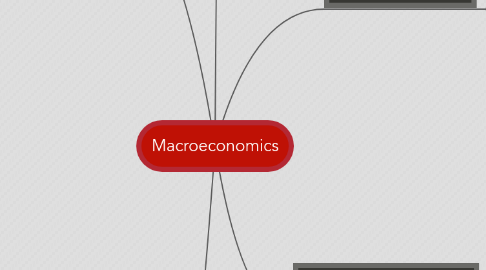
1. Inflation
1.1. Definition: The general, sustained rise in the price level of goods and services over a period of time.
1.2. There are two causes of inflation.
1.2.1. Demand-pull inflation happens when the level of aggregate demand rises above trend output, there by creating a positive output gap, so firms respond by raising their prices.
1.2.2. Cost-push inflation happens when firms experience a rise in costs, so they respond by increasing their prices to consumers to cancel out the high costs.
1.3. The rate of inflation measures the rate of change in prices.
1.4. Inflation is measured using three different methods.
1.4.1. Retail price index (RPI)
1.4.2. Retail price index excluding mortgage interest payments (RPIX)
1.4.3. Consumer price index
1.4.3.1. This is the official measure of inflation in the UK
1.5. New node
2. Unemplyment
2.1. Definition: Those of a working age who are out of work, actively seeking jobs to be hired at the current wage rates (or more). It is expressed as the percentage of the total available work force.
2.2. Two ways of measuring unemployment
2.2.1. Claimant count- People who claim unemployment benifit.
2.2.2. Labour Force Survey (LFS)- Produced by the international Labour organisation and it is a quarterly servey of about 60,000 households.
2.3. There are 5 main causes of unemployment
2.3.1. Cyclical unemployment- This occurs when there is a negative output gap and the economy is operating below potential because aggregate demand is too low.
2.3.2. Structural Unemployment- This exists when the structure of the economy changes where the decline of old industries create new industries, but people are no longer trained or willing to move into the new industries.
2.3.3. Fictional Unemployment- This is when people are 'in between' jobs, where they are spending time looking for or moving between jobs.
2.3.4. Seasonal Unemployment- This can result from fluctuations in weather conditions or/ and demand. Most common in tourism, agriculture and construction.
2.3.5. Classical Unemployment- This happens when the real wage is above the labour market equilibrium, i.e. the market fails to clear.
2.4. Cures of Unemplotment
2.4.1. Cyclical Unemployment- Cured by 'demand-side policies' where the monetary and fiscal policies must be loosened (Fiscal- Government spending up, taxes down. Monetary- Interest rates down and quantitative easing). This will raise the level of aggregate demand and reduce the level of unemployment.
2.4.2. Structural, Frictional, Classical and Seasonal unemployment- Cured by 'Supply-side policies'. For structural, you can increase mobility: for occupational, do more training and education. For Geographical, you can improve infrastructure, decrease stamp duty, ease planning permission and give tax breaks for firms. For Frictional, you can improve information by increasing job centers and internet. You can also decrease minimum wage and increase anti-union legislation's.
2.5. Consequences of Unemployment
2.5.1. Loss of income and standard of living to the individual.
2.5.2. People lose their skills because they are out of work for long periods of time.
2.5.3. The government loses money by paying benefits to the unemployed.
2.5.4. The government loses tax revenue from income tax and national insurance contributions,
2.5.5. The economy as a whole decreases in output and can go into recession.
2.5.6. Spending power decreases
2.5.7. People fall into debt
2.5.8. Depression kicks in.
2.5.9. Negative multiplier effects come in where one persons spending is another persons income, which can lead to a drop in demand for local services, downward pressure on house prices.
3. The Macroeconomic Performance
3.1. Definition: A set of long-term policies that will increase productivity and shift aggregate supply (AS) to the right, in an attempt to bring stability and improve an economy.
3.1.1. Examples: Improving education, training and skills programs, immigration, lower income tax reduced benefits, decreased union power, innovation, research and development, technology, entrepreneurship, competition etc...
3.2. New node
4. The Supply Side
4.1. Definition: A set of long-term policies that will increase productivity and shift aggregate supply (AS) to the right, in an attempt to bring stability and improve an economy.
4.2. Examples: Improving education, training and skills programs, immigration, lower income tax reduced benefits, decreased union power, innovation, research and development, technology, entrepreneurship, competition etc...
5. The Current Account
5.1. The balance of payments is split into two main accounts
5.1.1. The Current Account
5.1.1.1. Measures trade in goods and services
5.1.1.2. Current account deficit- an economy's total spending > total income
5.1.1.2.1. Has to be financed through a capital account surplus
5.1.1.3. +Exports of goods
5.1.2. The Capital Account
5.1.2.1. Measures activity in borrowing and lending, i.e. trading assets
